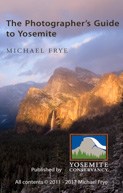Yosemite Photo Conditions
by Michael Frye | Mar 5, 2013 | Yosemite Photo Conditions

Winter sunrise from Tunnel View. With the right conditions Tunnel View can be great in the morning as well as the afternoon
January and February are the wettest months of the year in Yosemite. The average precipitation for January is 6.5 inches, while for February it’s 6.7 inches, which makes 13.2 inches for the two months combined.
But this year Yosemite received only a tenth of that: 1.33 inches total for January and February. The Sacramento Bee says it’s the driest January and February on record for the northern Sierra Nevada.
Since storms have been so rare lately, any forecast that calls for precipitation is big news, and we’ve got just such a forecast this week. Meteorologists are predicting a medium-sized storm to reach Yosemite tonight and tomorrow, with lingering showers on Thursday and Friday. The timing is hard to predict from the current forecast, but it’s likely that we’ll see clearing storm conditions either late Wednesday, Thursday or Friday. With the showery weather there may be several clearing-storm events during that time.
(more…)
by Michael Frye | Feb 22, 2013 | Yosemite Photo Conditions
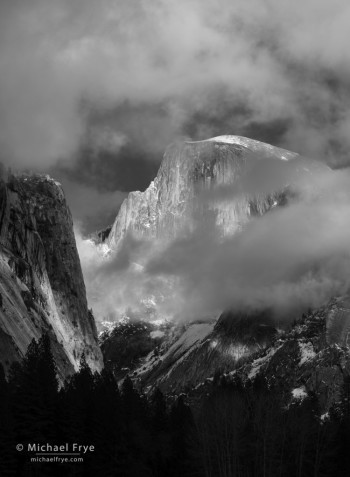
Half Dome and clouds, Yosemite NP, CA, USA
Many people, including me, had high hopes for the snowstorm that came through Yosemite on Tuesday. The forecast called for six to twelve inches of snow, so it sounded like we would see some beautiful snow scenes, and maybe even get to photograph a clearing storm. And some moisture might help revive Horsetail Fall.
Around sunset on Tuesday it started snowing at my house in Mariposa — first lightly, then heavily. In no time we had three or four inches of snow, and eventually got six inches, which is a lot for our 2700-foot elevation.
But the storm looked very compact on radar, and the precipitation didn’t seem to be reaching Yosemite. I called my friend Kirk Keeler, who lives in Yosemite Valley, and he told me that they had received only half an inch of snow.
Wednesday morning Claudia and I cleared the snow off our car and drove up to Yosemite Valley. We found an inch or two of snow — not a lot, but enough to highlight every tree branch. I saw many beautiful scenes with trees etched in snow, including the pattern of cottonwood branches below.
The morning was clear, but later some evaporation clouds started to appear, and they kept building. By the end of the day all the cliffs were hidden by clouds. But between 4:00 to 4:30 in the afternoon Half Dome and the clouds put on a great show. Half Dome would vanish completely, then reappear, wrapped in clouds and speckled with sunlight. I made the photograph above just before Half Dome disappeared for good.
(more…)
by Michael Frye | Feb 16, 2013 | Yosemite Photo Conditions
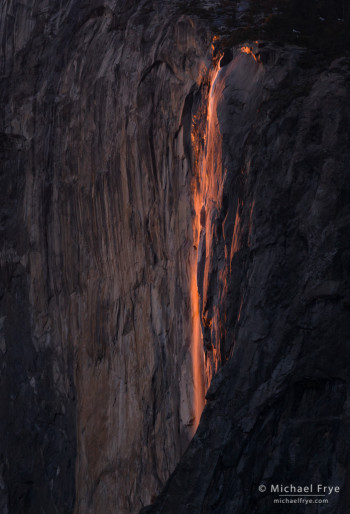
Horsetail Fall at 5:34 p.m. yesterday
It’s been quite dry in Yosemite since December, but there’s still some snow on top of El Capitan, and I thought that the warming weather over the last few days would melt some of that snow and increase the water flow in Horsetail Fall. But the flow is still disappointingly meager. I had a chance to photograph Horsetail last night, and I would say the water level is about the same as last year. The accompanying photograph was made from the Southside Drive area at about 5:30 p.m. yesterday. What water there is gets nicely highlighted when the light is just right, especially near the bottom of the fall, but… I wish the flow was better.
With low water like this I think the Southside Drive spot (Location 10 in my Photographer’s Guide to Yosemite book and iPhone app) works a little better than Rowell’s View near the El Capitan picnic area along Northside Drive (Location 1). From Southside Drive you’re a little further away, and you can see a bit more of the bottom of Horsetail Fall, which is the part that shows up best with conditions like this.
It’s supposed to be warm again today, so that might help increase the flow, but then temperatures are expected to trend downward tomorrow and Monday. On Tuesday forecasters are predicting the arrival of a snowstorm, which is expected to leave even colder air in its wake. The bad news is that the colder temperatures will slow down the flow in Horsetail Fall. The good news is that… a snowstorm is coming! And that, of course, brings the possibility of photographing snowy trees and cliffs, and maybe a clearing storm.
(more…)
by Michael Frye | Feb 13, 2013 | Yosemite Photo Conditions
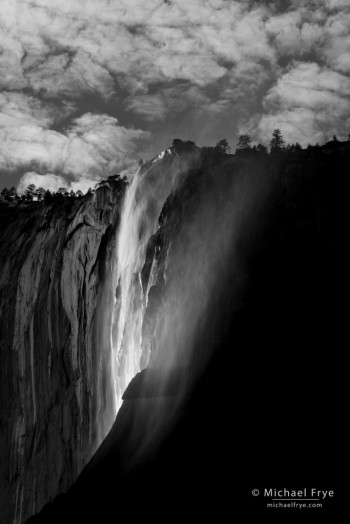
Horsetail Fall and clouds on a March afternoon, Yosemite NP, CA, USA
I’m happy to be up and running after dealing with some computer issues, and can give you a quick report on Horsetail Fall. During a private workshop on Monday I had a chance to check out the water flow. I’d say it’s a little below average for mid-February, but definitely better than last year. Despite six weeks of mostly dry weather there’s still some snow on top of El Capitan to feed the waterfall, and temperatures are supposed to rise a bit this week, which should help melt that snow and increase the water volume.
The window of best light for Horsetail Fall starts this weekend and lasts about a week to ten days. If our dry spell continues we should see some clear skies at sunset during that time — an essential requirement for the Horsetail light show. But the long-range forecast calls for precipitation next Tuesday and Wednesday, so we’ll see.
As a reminder, I’ll be at the reception for my exhibit at The Ansel Adams Gallery this Saturday from noon to 2:00 p.m., and also at the Yosemite Renaissance opening reception the following Friday, February 22nd, from 5:30 to 7:30 p.m. at the Yosemite Museum. I hope to see you at one of those events if you’re in the area!
— Michael Frye
Related Posts: Horsetail Fall Questions; The Best Time to Photograph Horsetail Fall, Revised
Michael Frye is a professional photographer specializing in landscapes and nature. He is the author and photographer of The Photographer’s Guide to Yosemite, Yosemite Meditations, and Digital Landscape Photography: In the Footsteps of Ansel Adams and the Great Masters, plus the eBooks Light & Land: Landscapes in the Digital Darkroom, and Exposure for Outdoor Photography. He has written numerous magazine articles on the art and technique of photography, and his images have been published in over thirty countries around the world. Michael has lived either in or near Yosemite National Park since 1983, currently residing just outside the park in Mariposa, California.
by Michael Frye | Jan 31, 2013 | Yosemite Photo Conditions
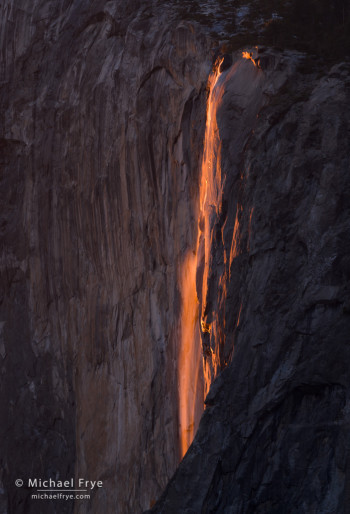
Low water, but ideal light on Horsetail Fall, February 20th, 2012
It’s almost February, so naturally I’ve been getting a lot of questions about Horsetail Fall. My thoughts about the best time to photograph Horsetail haven’t changed since I wrote this post last year: basically it’s February 16th to 23rd, or maybe a little beyond that.
This window was confirmed by my observations in 2012. There wasn’t much water in the fall last year, but we had a string of clear days, which allowed me to closely watch the light, and I think that February 16th to 23rd window is about right. You can, of course, take good photographs before or after that window; I’m talking about ideal light.
That ideal light requires clear skies to the west at sunset, something no one can predict at this point. And for good photographs the waterfall has to be flowing. Overall we’ve had a lot more rain and snow than last year, and Horsetail is flowing now. January, however, has been pretty dry, and there’s no precipitation in the forecast until at least next Wednesday. I think Horsetail will have more water this year than last, regardless of what happens over the next couple of weeks, but it would be nice to get some more snow on top of El Capitan soon to help feed Horsetail.
(more…)
by Michael Frye | Dec 4, 2012 | Yosemite Photo Conditions
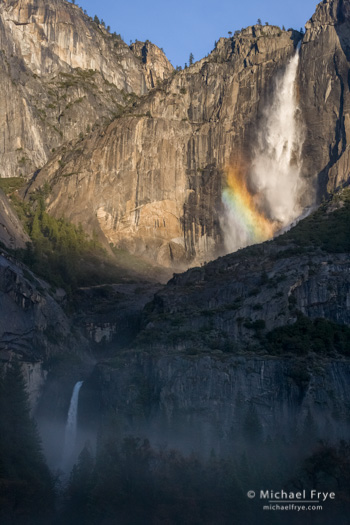
Upper and lower Yosemite Falls with a rainbow
For 20 years my wife Claudia and I lived in Yosemite Village, right underneath Yosemite Falls. In spring, when full from snowmelt, the roar from the fifth-highest waterfall in the world was the background music to our life in Yosemite Valley.
In late summer and autumn Yosemite Falls diminishes, sometimes dwindling to a wet stain on the cliff below Yosemite Point. This year it dried up even earlier than usual, a casualty of last winter’s meager snowfall.
But last week a series of warm, wet storms soaked northern California. Yosemite Valley received almost seven inches of rain between Wednesday morning and Sunday evening. Yesterday, after the storms finally departed, I drove up to Yosemite Valley, stepped out of my car at Swinging Bridge, and heard that familiar sound: the rumble of Yosemite Falls. It’s back, and so are all the other waterfalls in the Valley. It seemed more like May than December, except that the grasses were brown, and the trees were mostly bare with lingering splashes of fall color.
One of Yosemite’s photographic ironies is that in spring, when the thunder of Yosemite Falls rattles windows in Yosemite Village, the sun only hits the fall during the middle of the day. In winter the sun strikes the upper fall with beautiful, warm, low-angle light shortly after sunrise. You can even see rainbows from the right spot. But of course the flow is usually low during these colder months — except, that is, when heavy, warm rains fall, like they did last week.
(more…)














